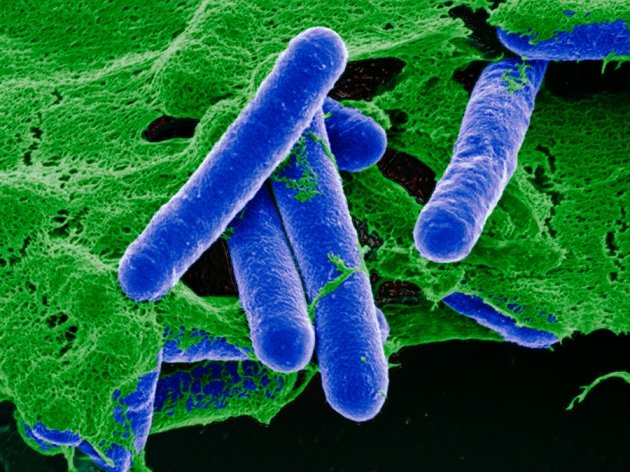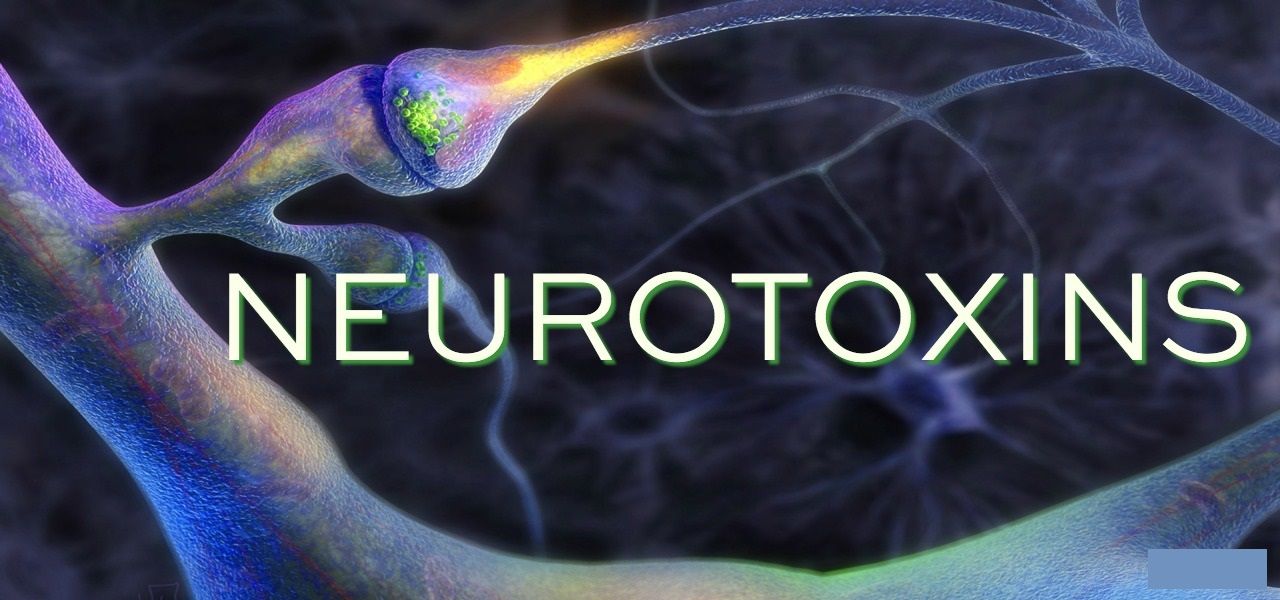Neurotransmission and Neurotoxins II
Target I: the Sodium Channel
The voltage-gated sodium channel is target of numerous neurotoxins, e.g. Tetrodotoxin. This compound occurs in several parts of the well-known puffer fish and specifically blocks the sodium channel, hence prohibits depolarisation and therefore signal transmission along an axon. In Japan puffer fish is known as "fugu" and is a delicacy that may only be prepared by certified chefs, trained in puffer fish anatomy. Nonetheless there are roughly 100 deaths per year due to false preparation of the fish by untrained chefs and amateurs.
Another potent sodium channel inhibitor is Saxitoxin, which is produced by marine dinoflagellates, a type of plankton known as the "red tide" (see image to the right). The toxin may be concetrated many-fold by filter-feeding shell fish to such an extent, that a small mussel can contain sufficient saxitoxin to kill up to 50 people!
Saxitoxin and Tetrodotoxin both have a guanidino group (highlighted in red) and both are effective only if applied to the neuron extracellularly. Hence it is concluded that the guanidino group binds to carboxylate groups at the outside entry of the sodium channel and hereby blocks it.
To stick with the sodium channel inhibitors, Batrachotoxin is discussed next: This is the most potent venom (toxin of an animal) known and has an LD50 = 2 μg/kg.
Batrachotoxin is a steroidal alkaloid, which is secreted by the skin of Phyllobates aurotaenia, a Columbian arrow-poison frog from the tropical Coco region. Although batrachotoxin also inhibits the sodium channel specifically it has a different mode of inhibition: In contrast to the previous presented ones, it renders the axonal membrane highly permeable to sodium, hence causes a permanent depolarisation. In fact this effect is reversed by tetrodotoxin! - They appear to be competitive ligands.
To finish the first part about sodium channel inhibitors it shall be mentioned, that American scorpions produce neurotoxic proteins - with a lenght between 60 - 70 amino acids - which also specifically bind to the sodium channel. However these proteins do not compete with tetrodotoxin and hence must have a different binding site.
Target II: the Release Mechanism of Acetylcholin
The black widow spider, Latrodectus mactans, produces a neurotoxic venom protein called α-Latrodoxin. The protein inserts into the presynaptic plasma membrane and acts as a calcium-ionophore. This leads to a massive, uncontrolled release of Acetylcholin (ACh) into the synaptic cleft. The structure of this toxin is shown in the next image and exhibits a central pore, through which the calcium ions can enter the presynaptic cell in an uncontrolled fashion, hence without any corresponding stimulus (arriving action potential).
The black widow spider inhabits most warmer regions of the world. Its' venom is 15-times more toxic that that of the female prairie rattlesnake. However, due to only small amounts of injected venom the bites are usually not fatal.
In contrast to α-Latrodoxin, Botulinus toxin inhibites the release of ACh at the neurotransmitter junction. Botulinus toxin is a large protein and is produced by the anaerobic gram-positive bacterium Clostridium botulinum.
This compound now is the most toxic substance known to man with an LD50 = 1 - 2 ng/kg!

Clostridium botulinum - Image Source
The bacterium is responsible for the deadly food poisoning called botulism. For an illustration of the structural setup of the toxin, have a look at the sketch to the right. After cleavage into a light and heavy chain the toxin enters the axon terminal. Inside, the disulfide bond is reduced and the light chain, a zinc-metalloprotease, released. The selective destruction of proteins implicated in exocytosis of vesicles impairs the release of neurotransmitters into the synaptic cleft.
Target III: The ACh Receptor
The ACh receptors of the postsynaptic cell are target of some of the most deadly known neurotoxins. Death occurs typically as a result of respiratory failure due to the inhibition of neuromusculuar junctions.
As the first example the harlequin poison frog (Dendrobates histrionicus) with its' secreted neurotoxin, a piperidine alkaloid called Histrionicatoxin, shall be mentioned. It is a very potent antagonist to ACh and prevents the ACh receptor channel opening.
Furthermore many poisonous snakes contain small, neurotoxic proteins in their venom. Examples are:
- α-Bungarotoxin (from kraits: Bungarus sp.)
- Erabutoxin (from sea kraits: Laticauda)
- Cobratoxin (from spitting cobra: Naja siamensis)
These proteins all bind to the ACh receptor and prevent channel opening. Also do the mentioned snake venom proteins all have a common fold: the snake-toxin like fold consists of a central antiparallel ß-sheet and several disulfide bonds (indicated in orange in the illustration below), that render the structure compact and rigid.
Not only sea snakes but also other creatures of the sea are venomous predators: Marine molluscs with more than 500 species in the Conus genera and over 50.000 suspected active compounds are most noticeable!
Also flora can produce very powerful neurotoxins: South American indians use curare (Tubocurarine), which is extracted from the vine Chondodendron tomentosum to coat the arrows of their blowguns. This substance very efficiently blocks the ACh receptor at neurotransmuscular junctions and hence causes relaxation and paralysis of muscules including respiratory organs!
I hope you liked this brief presentation of the most potent and famous neurotoxins and their point of action. Due to the similarities in content, I will soon write a short article about chemical warfare agents. If you have any questions or suggestions feel free to include them in the comments. I will respond to them as soon and complete as possible.
Best,
mountain.phil28
References:
Information and non-direct-cited images are taken from
"Molecular Physiology" lectures at the TU Graz.

Interesting article.
I would also include Monodsodium Glutamate, Sodium Inosinate + Sodium Guanylate, and Fluoride to that list of neurotoxins.
By the way, you can drop the "s" from "Information."
Downvoting a post can decrease pending rewards and make it less visible. Common reasons:
Submit
Hi
Thanks for your comment. Of course this is not meant to be a complete list of all neurotoxins. Do you know how the substances you mentioned influence our neuronal network?
Oh, thx for pointing out this typo. :-)
Best,
mountain.phil28
Downvoting a post can decrease pending rewards and make it less visible. Common reasons:
Submit
I understand about it not being a complete list, I thought I'd just contribute more, especially something I'm somewhat passionate about. By the way, I stopped using flouride toothpaste years ago and my teeth are doing well. Shame on you Tom's of Maine for even including that in your product line. I know we can't totally avoid flouride/flourine since it's imposed on us without consent via many municipal waters, but this is why I use a multistaged water filtration system with reverse osmosis. I used to use on on my shower head, but those don't take hot water very well for long, and doesn't filter out fluorine very well; a whole house filtration system would be best. I personally did an extensive research on effects of fluorine/Fluoride, a substance not made by the human body, or is it required for general nor specific health reasons. Flourine is a great substance for the earth's health since it is part of the earth's chemistry.
MSG is a neuroexciter and deceives our taste receptors to give us the "feeling" of a substances flavor more enhanced. It's over stimulating those taste neurons, and when something's over stimulated long enough gets fatigued, and in some cases shuts down. For some the side effects of MSG, and Sodium Inosinate + Sodium Guanylate causes headaches within a few minutes to a few hours later. MSG in high amounts, I don't remember the dosage level, is given to a new patient suspected of having seizures to induce the seizure if they are prone to such. The FDA, at least recently, admits not being perfect at knowing everything but what they say "Because of inherent limitations of science, FDA can never be absolutely certain of the absence of any risk from the use of any substance."
You can find side effects of different substances used in foods and drugs on https://www.fda.gov/Food/IngredientsPackagingLabeling/FoodAdditivesIngredients/ucm094211.htm
There are other sites that are more up to date, which have researched effects, and studies on many substances. Depending on the substance, I think of the slow kill effect, as such stories we hear of such as a Queen or King who slowly poisons to death an heir to the throne to favour the lesser. Mithridatism doesn't work for all substances either.
Sorry about that. I meant that typo correction humbly. If there's a way in this platform to direct message(private message) would be great.
Downvoting a post can decrease pending rewards and make it less visible. Common reasons:
Submit
Wow! One of the most indepth articles I've seen on Steemit. Great job. Hope you keep writing.
Downvoting a post can decrease pending rewards and make it less visible. Common reasons:
Submit
Of course. As long as there are people who appreciate my work I will go on. ;-)
Downvoting a post can decrease pending rewards and make it less visible. Common reasons:
Submit
wow<mesmerized..its shiiny.. ^^ time for Q&a, now? :p soooo did i miss how many fatalities we have using ACh ? as you nicley stated em all for the Na+K pump :) isent it so cool how ACH actauuly have higher fatalities (im taking in the fact of Na+Kpump is in every cell)
some were, im can be out fishing<pun sooo intended ^^ i think highest ratio of poisenous animals actually are found at sea.. Hm cant remember my sorce ..hm must look at that.. Hmf
LOVE that you placed out chemical compounds charts like that, makes it way easier to look and follow :D me like that :D hm i found something, up there some were>>>
nice ,i dident know that :D
super job, great break down and easy to follow :D :D woohoo you
Downvoting a post can decrease pending rewards and make it less visible. Common reasons:
Submit
Being "wohoooed" is nice :-)
Downvoting a post can decrease pending rewards and make it less visible. Common reasons:
Submit
Congratulations @mountain.phil28! You have completed some achievement on Steemit and have been rewarded with new badge(s) :
Click on any badge to view your own Board of Honor on SteemitBoard.
For more information about SteemitBoard, click here
If you no longer want to receive notifications, reply to this comment with the word
STOPDownvoting a post can decrease pending rewards and make it less visible. Common reasons:
Submit
Congratulations @mountain.phil28, this post is the ninth most rewarded post (based on pending payouts) in the last 12 hours written by a User account holder (accounts that hold between 0.1 and 1.0 Mega Vests). The total number of posts by User account holders during this period was 3125 and the total pending payments to posts in this category was $3341.42. To see the full list of highest paid posts across all accounts categories, click here.
If you do not wish to receive these messages in future, please reply stop to this comment.
Downvoting a post can decrease pending rewards and make it less visible. Common reasons:
Submit
https://www.ebuyclub.com/?par rain=fatimedebuy
rain=fatimedebuy
Downvoting a post can decrease pending rewards and make it less visible. Common reasons:
Submit